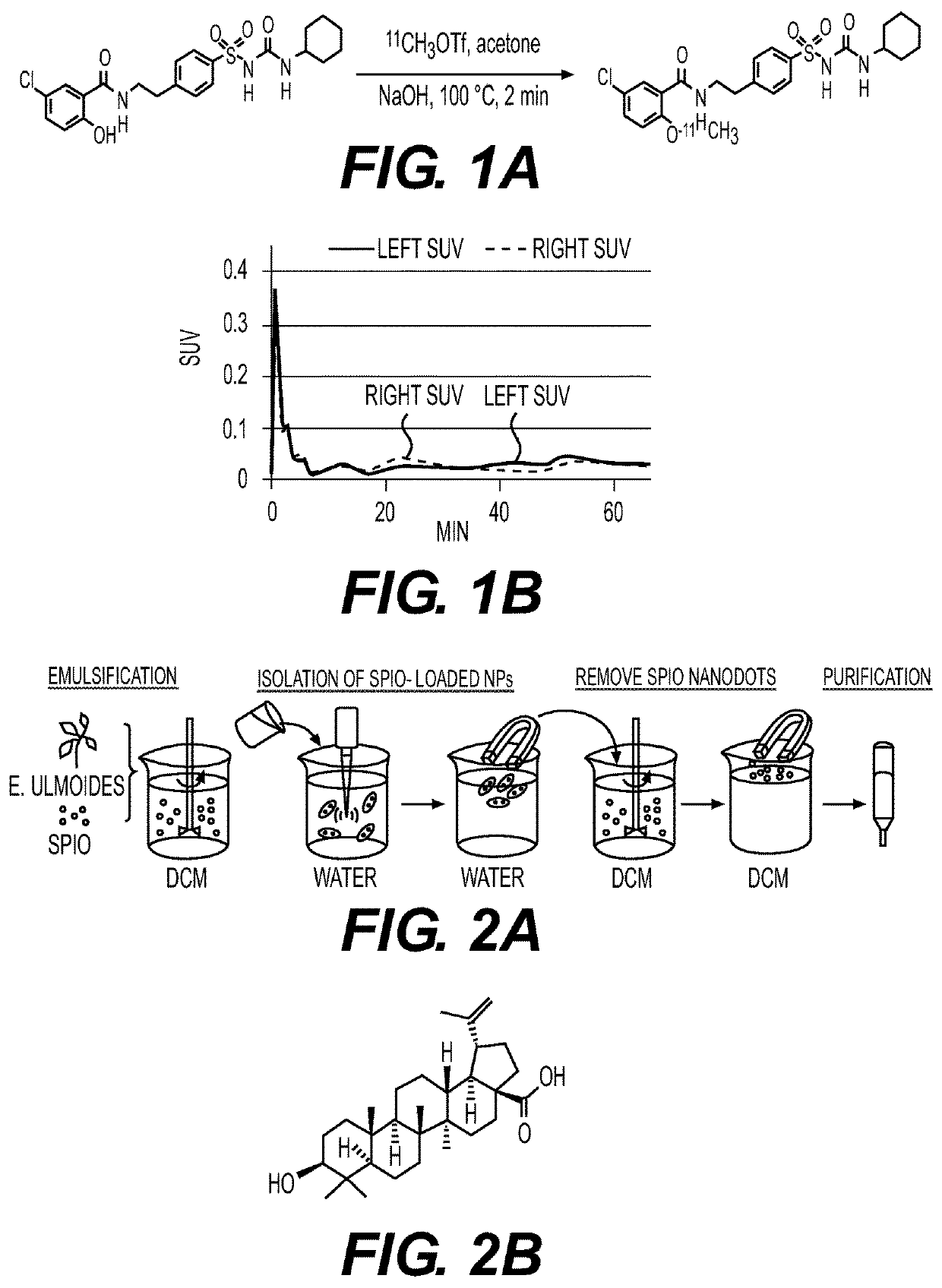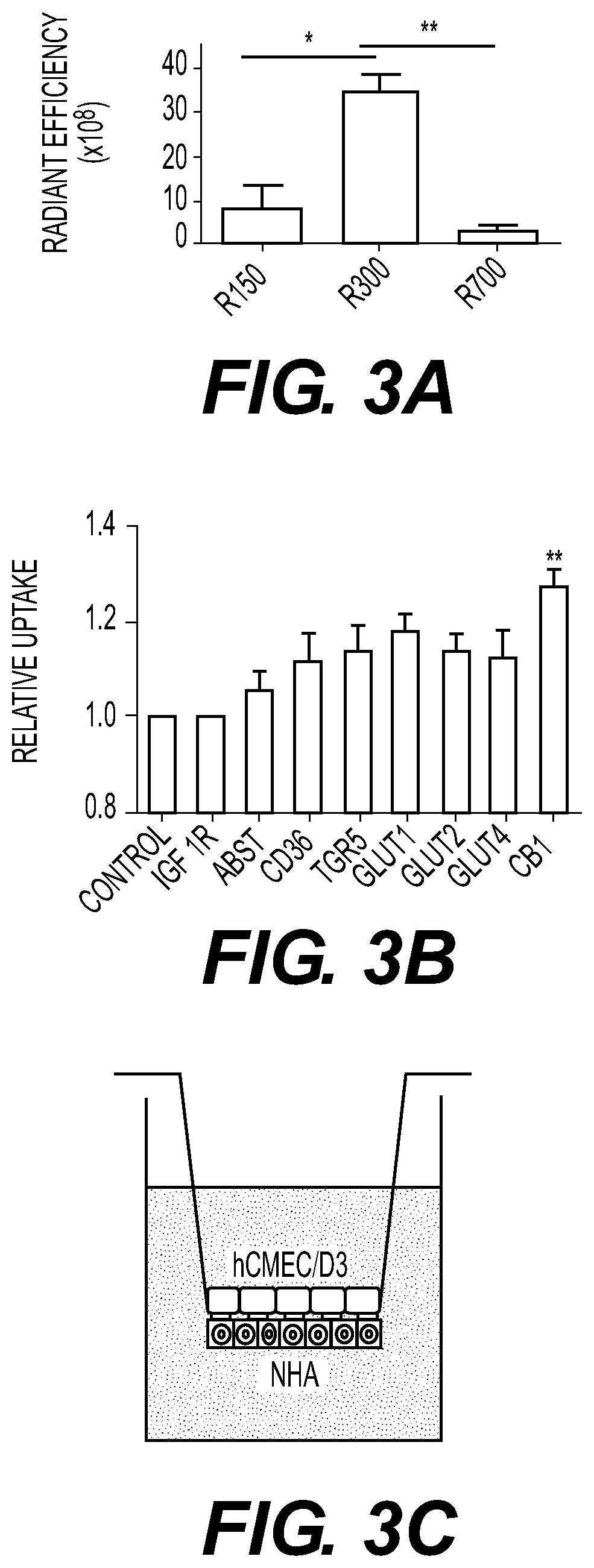Nanoparticle mediated therapy
a technology of nanoparticles and nanoparticles, applied in the direction of nanoparticles, microcapsules, capsule delivery, etc., can solve the problems of loss of activity of encapsulated drugs and regulatory compliance issues, and achieve the effects of reducing infarct volume, reducing infarct activity, and reducing infarct activity
- Summary
- Abstract
- Description
- Claims
- Application Information
AI Technical Summary
Benefits of technology
Problems solved by technology
Method used
Image
Examples
example 1
on into the Brain of Glyburide
[0163]Glyburide has a limited ability to penetrate the BBB and intravenous administration of glyburide cannot achieve a therapeutic level in the brain (Tournier, et al. Aaps J 2013, 15 (4), 1082-90; Lahmann, et al. PloS one 2015, 10 (7), e0134476). This may be due to inadequate delivery of glyburide to the ischemic brain.
[0164]Substantial evidence suggests that SUR1, the molecular target of glyburide, is highly expressed in cells in the neurovascular unit, including neurons, astrocytes, and oligodendrocytes after stroke, which contribute significantly to cerebral edema (Simard, et al. Nature medicine 2006, 12 (4), 433-40 22; Kahle, et al Physiology (Bethesda) 2009, 24, 257-65; Liang, et al. Neurosurgical focus 2007, 22 (5), E2; Sheth, Stroke; a journal of cerebral circulation 2013, 44 (6 Suppl 1), S136). It is clear that further improving the efficacy of glyburide requires enhancing the delivery of glyburide beyond the BBB to allow its engagement with n...
example 2
ation of BA as a Nanoparticle Forming Material
[0177]A chemical extraction approach was developed and used to test the hypothesis that certain medicinal herbs contain natural nanomaterials by analyzing E. ulmoides. In order to isolate nanomaterials that enable agent encapsulation, hydrophilic superparamagnetic iron oxide (SPIO) nanodots, (Strohbehn, et al. Journal of neuro-oncology 2015, 121 (3), 441-9) were used as the payload (FIG. 2A).
Materials and Methods
[0178]As the first step, an extract of E. ulmoides was prepared by soaking it in dichloromethane (DCM), following by filtration. Next, the extract was emulsified with SPIO. SPIO-encapsulated NPs were then collected using a magnet. Successful encapsulation of SPIO was confirmed by transmission electron microscope (TEM).
[0179]After lyophilization, the SPIO-encapsulated NPs were dissolved in DCM. Free SPIO were removed by magnetization. The resulting extractant was separated using column chromatography. Different fractions were eval...
example 3
r Delivery to the Ischemic Brain
Materials and Methods
[0188]BA NPs were synthesized using DCM as the solvent, water as the aqueous phase, and 4° C. as the evaporation temperature, as described in Example 2. The shape and size of BA NPs were tunable by varying the organic phase, aqueous phase, and evaporation temperature. When a combination of ethyl acetate (EA) (solvent), water (aqueous phase), and 4° C. (evaporation temperature) was used, BA NPs were obtained with a size of 156(1)×45(d) nm as demonstrated by SEM imaging. When a combination of EA (solvent), NaOH solution (aqueous phase), and 25° C. (evaporation temperature) was used, BA NPs were obtained with a size of 730(1)×35(d). To simplify the nomenclature, BA NPs in the size of 156(1)×45(d) nm, 315(1)×60(d) nm, and 730(1)×35(d), were referred to as R150, R300, and R700, respectively.
[0189]R150, R300, and R700 were evaluated for delivery to the ischemic brain. NPs were synthesized with encapsulation of IR780, a near-infrared dye...
PUM
| Property | Measurement | Unit |
|---|---|---|
| Fraction | aaaaa | aaaaa |
| Fraction | aaaaa | aaaaa |
| Fraction | aaaaa | aaaaa |
Abstract
Description
Claims
Application Information
 Login to View More
Login to View More - R&D
- Intellectual Property
- Life Sciences
- Materials
- Tech Scout
- Unparalleled Data Quality
- Higher Quality Content
- 60% Fewer Hallucinations
Browse by: Latest US Patents, China's latest patents, Technical Efficacy Thesaurus, Application Domain, Technology Topic, Popular Technical Reports.
© 2025 PatSnap. All rights reserved.Legal|Privacy policy|Modern Slavery Act Transparency Statement|Sitemap|About US| Contact US: help@patsnap.com



